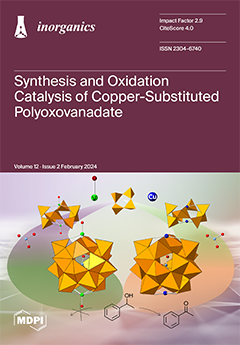We herein report on the synthesis and structural characterization, as well as on the photophysical properties, of a series of isoleptic Pt(II) and Pd(II) complexes featuring tridentate N^N^N chelators as luminophores while bearing diverse ancillary co-ligands. Six new palladium complexes were synthesized using 2,6-bis(3-(
tert-butyl/
trifluoromethyl)-
1H-1,2,4-triazol-5-yl)pyridine (
tbu or
CF3, respectively) in combination with four distinct ancillary ligands, namely: 4-amylpyridine (
AmPy), 2,6-dimethylphenyl isonitrile (
CNR), triphenylphosphane (
PPh3), and 1,3,5-triaza-7-phosphaadamantane (
PTA). Thus, two novel Pt(II) complexes incorporating the co-ligands
CNR and
PTA were explored. The remaining platinum-based complexes, namely
CF3-Pt-AmPy,
tbu-Pt-AmPy,
CF3-Pt-PPh3, and
tbu-Pt-PPh3, were re-synthesized according to our previous work for a systematic comparison with their Pd(II) homologues. Thus, photophysical studies were performed in different solvents and conditions. The Pt(II) complexes demonstrated comparable or superior photophysical characteristics in toluene when compared with their solutions in liquid dichloromethane at room temperature. In contrast, the Pd(II) complexes exhibited no significant photoluminescence in dichloromethane, but a surprisingly clear emission was observed for
tbu-Pd-AmPy,
tbu-Pd-CNR, and
tbu-Pd-PPh3 in liquid toluene at room temperature. The significant differences regarding excited state lifetimes and photoluminescence quantum yields underscore the impact of solvent selection on photophysical characteristics, emphasizing the need to consider metal-ligand interactions, as well as the surrounding microenvironment, for a comprehensive interpretation of their photophysical properties. In addition, it is clear that
AmPy and
CNR render better luminescence efficiencies, whereas
PTA is only suitable in toluene.
Full article





